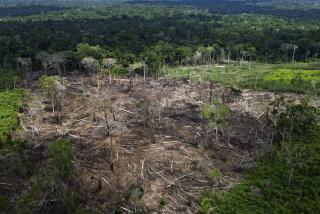Conflict Marks Endangered Species Treaty
FT. LAUDERDALE, Fla. — Sitting at opposite ends of a cavernous auditorium, under a canopy of flags from around the world, Brazil and the Netherlands waged a polite but emotionally strained debate over a tree that grows thousands of miles away.
The chief delegate from the Netherlands--whose Dutch people are fierce rain forest defenders--argued that mahogany trees are disappearing from the tropics so rapidly that trade in the wood must be restricted. Brazil’s delegate fervently protested, saying his people should control the Amazon forests.
For the 118 nations that gathered in Florida for two weeks of high-level talks on the environment, which ended Friday, both arguments were persuasive. Ultimately, the government ministers voted, by a slim margin, to leave trade in mahogany unrestricted.
The conflict over mahogany--a rich, highly prized tropical wood that graces the living rooms of many American homes--symbolizes a new direction for the world’s largest and most powerful conservation treaty, the 21-year-old Convention on International Trade in Endangered Species. Should its decisions on wildlife be based on science, politics, economics or emotion? Is it firstly a conservation treaty, or a trade treaty? For the 124 nations that signed the pact, the answer is increasingly all of the above.
At the core of the debate is one of the most wrenching environmental questions: Which of the world’s creatures warrant protection? Already, international trade is prohibited for more than 600 species from leopard skins and tiger bone to whale meat and rhino teeth. Trade is restricted for 25,000 other species.
In last week’s talks, it was evident that more nations are prepared to accept the concept of “sustainable use,” which maintains that if governments are allowed to trade threatened natural resources, such as elephants or wild orchids, or the plant used to manufacture the anti-cancer drug taxol, in limited amounts, then they will have more economic incentive to manage such resources in ways that will not drive them to extinction.
“It is a critical time for (the treaty),” said U.S. Fish and Wildlife Director Mollie Beattie, the chief U.S. delegate. “I see it moving into a much more thoughtful mode than it has been in. . . . People have realized that (sustainable use) is really the keystone of this treaty. It is a means of having countries help other countries and help themselves.”
Sustainable use adds a new twist to the classic battle between the international haves and have-nots.
Like any global treaty, the environmental pact known as CITES must navigate the murky and sometimes treacherous waters of international conflicts. Wealthier, pro-preservationist nations, especially in Europe, are often pitted against cash-poor but resource-rich nations such as Malaysia and Zimbabwe.
When the treaty was drafted 21 years ago, trade bans were rapidly enacted as tigers, crocodiles, chimpanzees and leopards slipped toward extinction. But now nations such as South Africa, Zimbabwe, Japan, Norway and Malaysia that are vocal supporters of allowing more trade in protected species increasingly are being heard.
The result has been a softening of extremes: Nations that used to demand to be left alone have agreed that they have to manage their natural resources well today to ensure their future existence. And those that used to support inflexible bans on trade now realize that if countries have healthy economies, they will have more money to spend on improving the environment.
Marinus S. Hoogmoed of the National Museum of Natural History in the Netherlands said that when he was a delegate in 1979, many of the nations that gathered were too rigidly preservationist. He heard the first rumblings of a shift in 1992, and this year in Ft. Lauderdale, many nations voted to ease restrictions that had seemed unthinkable a few years earlier, he said.
“Certain animals are still such a hot emotional item, such as elephants, that it is nearly impossible to even have any conversation about it,” Hoogmoed said. “But as far as I can see in the European Union, there certainly is an understanding that CITES is a mixture of trade and nature conservation, and you have to have both of them.”
Much of the credit--or blame--for the easing of restrictions goes to South Africa, which has won a lot of converts with its strong efforts to protect wildlife. Johan Neethling, who directs a South African conservation program, said the right to sustainable use is “vital to the long-term health of this whole organization” and “a principle of paramount importance for conservation in all of Africa.”
South Africa last week sought support for weakening the global ban on elephant trade, enacted after ivory poaching in the 1980s decimated much of Africa’s herds. Since its elephants have flourished, South Africa asked for permission to sell the hides of 350 elephants per year culled from its overpopulated national parks, earning about $1 million per year it vowed to put into its conservation budget.
The effort was rejected. But for the first time, many nations, including the United States and the entire European delegation, were sympathetic to South Africa’s request. Their representatives said they would have supported South Africa if other African nations weren’t vehemently opposed because they thought it would increase ivory poaching. However, South Africa was successful in easing the ban on trade in white rhinos, a critically endangered species everywhere but in South Africa. Other new rules allow ranching of sea turtles and ease restrictions on trade of crocodile skin.
“Especially in Africa, some less restrictive regime has to be found,” Beattie said. “What South Africa has done is break through what resistance there used to be and bring people around to thinking that Africa can come up with a long-term sustainable program for its wildlife.”
Still, some nations remain skeptical that countries without scientific expertise or adequate law enforcement can successfully protect their environment.
“In some countries, it is very possible. For others, it’s been a disaster,” Hoogmoed said.
Countries with a bad reputation for failing to protect their wildlife from illegal trade are Indonesia, Nepal and Colombia. An estimated $5 billion worth of wildlife products per year are legally and illegally traded worldwide, and the profits of the illegal side are thought to be eclipsed only by those of narcotics.
Gilbert Simon, director of the French Ministry of Environment’s Department of Conservation, said the theory of sustainable use works only when a species, such as crocodiles, is not very endangered and does not attract high prices.
“We, of course, agree on the principle of sustainable development. Everyone agrees,” he said. “But for this century, real sustainable development means strong and strict preservation because it’s impossible to control poaching. It will not work with elephants or rhino because people can sell tusks for 10 times the salary of the average African. It’s like drugs.”
A Canadian biologist and attorney, Ron Orenstein of the International Whaling Commission, said he “watched with horror the collapse of the world’s greatest fishery”--off the Atlantic coast of Canada--because harvesting that scientists had deemed sustainable depleted cod populations beyond repair.
The debate over tropical mahogany marked one of the first times that a product so vital to a nation’s economy had been considered under the pact.
Brazil is by far the largest exporter of mahogany and the United States by far is its largest consumer. A smooth, durable wood in a deep, reddish-brown hue popular for fine furniture, mahogany export is worth about $72 million per year to Brazil alone, making it one of the biggest commodities in the Amazon.
The Netherlands had proposed listing mahogany on the treaty’s appendix 2--which does not ban sales but requires exporting countries to keep track of harvests and set quotas that are sustainable in perpetuity. Many exporting nations, including Venezuela, Costa Rica, Colombia and Honduras, supported the listing as a way of helping to conserve their forests.
But after failed attempts to strike a compromise with the opposing nations of Brazil, Bolivia and Peru, 50 nations--including the United States--voted in favor of the listing, with 33 against. Because a two-thirds majority is required, the proposal failed by six votes.
Nilde Lago Pinheiro, president of the Brazilian Institute for Environment, said it was premature to list mahogany because “we are implementing our own legislation, which is even more rigorous.” She said Brazil has voluntarily reduced exports of mahogany from 174,000 cubic meters in 1989 to 90,000 in 1994. She adds, though, that the Brazilian government has been unable to stem widespread illegal harvesting by timber companies in remote rain forests.
While many mainstream environmental groups, including the World Wildlife Fund, support the pact’s new emphasis on sustainable use, some animal rights activists believe that it is headed in the wrong direction. “We’re not opposed to it in theory,” said John Grandy of the Humane Society of the United States. “It’s just that they don’t cut it in the real world.”
The Humane Society is concerned mostly about a decision to allow trophy hunting of some species such as rhinos. “If you feel strongly about supporting conservation programs, give them your money. Don’t kill their animals,” Grandy said.
Professor Marshall Murphree of the University of Zimbabwe contends, though, that the international community has a choice of either allowing limited trade or letting it happen anyway, uncontrolled and illegal.
“We are all users of wildlife,” he said. “It’s not an issue of whether it will be use or non-use. The real issue is whether that use can be sustainable or we abandon that and let it become unsustainable.”
While scientific data on the status of a species is supposed to rule conservation decisions, other factors--politics, emotions and economics--play key roles. Many nations were so disturbed by the lack of scientific basis for some decisions that they waged a two-year effort to craft new criteria, which were adopted unanimously last week.
More to Read
Sign up for Essential California
The most important California stories and recommendations in your inbox every morning.
You may occasionally receive promotional content from the Los Angeles Times.










